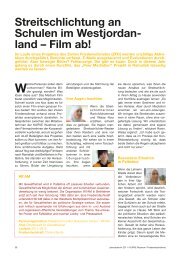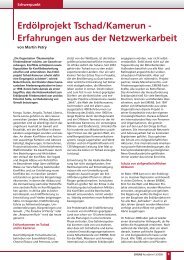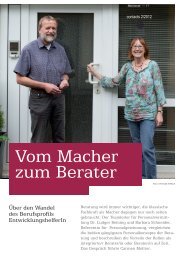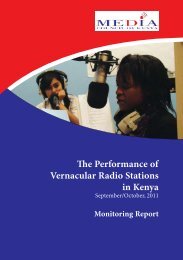Merging Ethiopian Wise-Counsel Mediation and Facilitative ...
Merging Ethiopian Wise-Counsel Mediation and Facilitative ...
Merging Ethiopian Wise-Counsel Mediation and Facilitative ...
- No tags were found...
You also want an ePaper? Increase the reach of your titles
YUMPU automatically turns print PDFs into web optimized ePapers that Google loves.
The Process of Active Listening:The key to active listening is for mediators to express both verbally <strong>and</strong> nonverbally that they are listening to the messages of theconflict parties.Verbal reactions that show that you are paying full attention to the speaker’s words are:> > Making supportive <strong>and</strong> encouraging statements like: "Go on." "Then what happened?" "Yes,I underst<strong>and</strong>." "Tell us more." "Could you explain what happened?" etc.> > Expressing acknowledgment: "I underst<strong>and</strong>." "I see." "O.K."> > Acknowledging having received the message: "Hmm." "Aha." "Oh."> > Verifying the content: "Is it correct that you said…"; "You seem to be angry about…"> > Asking for clarification: "I am not sure I underst<strong>and</strong>…"; "Did you say...?" "Can you give me an example?"But DO NOT:> > Offer your thoughts or any interpretations, interrogate or give advice. Active listening is about listening only!> > Use stock phrases like: "It's not so bad." "Don't be upset." "You’re making a mountain out of amolehill." "Just calm down." Phrases like these convey judgment instead of underst<strong>and</strong>ing.> > Get emotionally hooked, angry, upset or argumentative.> > Let your values <strong>and</strong> biases interfere with what you underst<strong>and</strong> is being said.Keep an open mind <strong>and</strong> try to truly underst<strong>and</strong> the speaker.Nonverbal reactions that show the speaker that you are fully paying attention to his/her words are: 42> > Showing an open body posture.> > Making appropriate gestures such as nodding.> > Using an appropriate amount of eye contact.> > Using a positive tone of voice.Generally, active listening requires a desire to underst<strong>and</strong> another human being; an attitude of respect <strong>and</strong> acceptance, <strong>and</strong> genuineempathy for the speaker. It dem<strong>and</strong>s that mediators set aside their own thoughts <strong>and</strong> agendas, suspend judgment <strong>and</strong> try to underst<strong>and</strong>the speaker's points, emotions <strong>and</strong> attitudes. This is a difficult task <strong>and</strong> has to be practiced. 4342 See also Chapter III.6.3 The Importance of Body Language in the <strong>Mediation</strong> Process, on page 62.43 This chapter is based on a h<strong>and</strong>-out used in the GIZ CPS inmedio series of mediation trainings in Ethiopia 2010-2011, which were compiledby inmedio <strong>and</strong> partly based on Niederberger von Wyl, J. (2009). Compare also Burgess, G. & Burgess, H. (Eds.) (2003).68 <strong>Mediation</strong> Trainer’s Manual
















